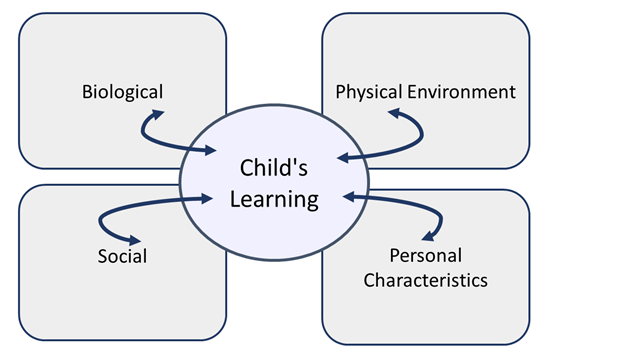10.5 Summary
Through the previous chapters we have seen there are many factors that influence how we learn. These include biological, personal characteristics, social, and the physical environment.

Long Description
Description of the image
Title: Integrated Factors in Children’s Learning
4 boxes with a circle in the middle. Each box has a double sided arrow that connects to the circle.
Boxes:
- Biological
- Physical Environment
- Social
- Personal Characteristics
Circle:
- Child’s Learning
References
Bronfenbrenner, U. (1979). Ecology of the family as a context for human development: Research perspectives. Cambridge. MA: Harvard University Press.
CDC (2107). Nationwide Youth Risk Behavior Survey: Data summary and trends report 2007-2017. Available at CDC Youth Risk Behavior Survey
Goldberg, S.B., et. al. (2018). Mindfulness-based interventions for psychiatric disorders: A Systematic review and meta-analysis. Clinical Psychology Review, 59, 52-60.
Jensen, E. (1998). Teaching with the brain in mind. Alexandria, VA, ASCD.
Lee, H., & Bonk, C.J. (2014). Collaborative learning in the workplace: Practical issues and concerns. International Journal of Advanced Corporate Learning. 7 (2), 10–17. doi:10.3991/ijac.v7i2.3850.
Lee, J. & Shute, V. (2010). Personal and social-contextual factors in K-12 academic performance: An integrative perspective on student learning. Educational Psychologist, 45, 185-202.
Ozbay, F., Johnson, D. C., Dimoulas, E., Morgan, C. A., Charney, D., & Southwick, S. (2007). Social support and resilience to stress: from neurobiology to clinical practice Psychiatry (Edgmont (Pa.: Township)), 4(5), 35–40.
Pressman, S. (2014) Hacking exam stress through psychological science. NOBA
Siegler, R. S., & Alibali, M.W., (2005). Ch. 4 Sociocultural theories of development. In Children’s thinking (4th ed.). Saddle River, NJ: Prentice Hall.
Ulrich, R.S., Simons, R.F., et al (1991). Stress recovery during exposure to natural and urban environments. Journal of Environmental Psychology. 11(3), 201-230. doi: 11016/S0272-4944(05)80184-7
